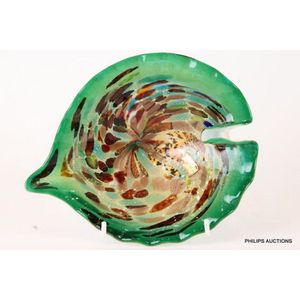Murano Aventurine Leaf Bowl with Polychrome Inclusions
A vintage Murano glass Tutti Fruti aventurine leaf bowl Avem. Distributed by Vetro Artistico Veneziano, circa 1950, the dark green and opaline encased leaf bowl, decorated with swirls of silver leaf inclusions, gold coloured copper aventurine and polychrome mottled canes in tones of orange, blue, and ruby; with red and gold distributor label, most likely from the Arte Vetraria Muranese (Avem) manufacture for distribution by Vetro Artistico Veneziano. Height 7 cm, length 26.5 cm, width 21 cm
You must be a subscriber, and be logged in to view price and dealer details.
Subscribe Now to view actual auction price for this item
When you subscribe, you have the option of setting the currency in which to display prices to $Au, $US, $NZ or Stg.
This item has been sold, and the description, image and price are for reference purposes only.
- Inclusions - Inclusions in glass objects refer to small, often irregularly shaped particles or bubbles that are trapped within the glass during the manufacturing process. These inclusions can be intentional or unintentional, and can range in size, shape, and composition.
Intentional inclusions are often added to the glass for decorative purposes, and can include materials such as colored glass, metallic foils, or even small mementos like photographs or other objects. These intentional inclusions are typically added to the glass while it is still in a molten or semi-molten state and are then moulded or blown into the final shape of the object.
Unintentional inclusions, on the other hand, are typically the result of impurities or air bubbles that become trapped within the glass during the manufacturing process. These inclusions can be seen as small specks or bubbles within the glass, and can sometimes be a sign of poor quality control during production.
While intentional inclusions can be a desirable feature of some glass objects, unintentional inclusions can sometimes be seen as a defect, and can reduce the value of a piece. However, in some cases, certain types of unintentional inclusions can actually increase the value of a piece, such as with antique glass that contains bubbles or other imperfections that are characteristic of the time period in which it was made. - Aventurine Glass - Aventurine glass is a type of glass where small flakes of gold, copper, or silver color form in the glass and provide a glitter or sparkle to the glass when seen in the light. The small flakes are created by adding copper, gold or silver to the molten glass during the glassmaking process.
- Opalescent / Opaline - The descriptions of glass as "opalescent" or "opaline" are often used interchangeably by dealers and auction houses. At the upper end of the scale, opalescent / opaline glass can refer to the opal-like milky blue glass produced by Lalique and Etling. It also refers to the pressed glass mass produced in Britain from the 1840s with a milky white edge as sugar-basins, milk jugs and vases were made in great quantities for the mass market, and were sold at fairs along with Staffordshire figures and wooden dolls. A less common type of opalescent glass was made from two layers of glass blown into a mould.
- Circa - A Latin term meaning 'about', often used in the antique trade to give an approximate date for the piece, usually considered to be five years on either side of the circa year. Thus, circa 1900 means the piece was made about 1900, probably between 1895 and 1905. The expression is sometimes abbreviated to c.1900.
- Polychrome - Made or finished in many colours. For furniture, it is used to indicated a painted finish.
This item has been included into following indexes:
